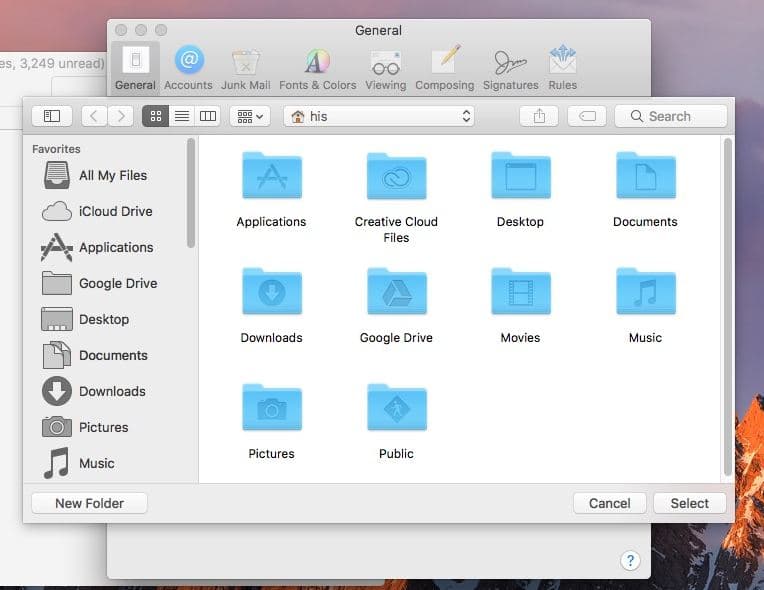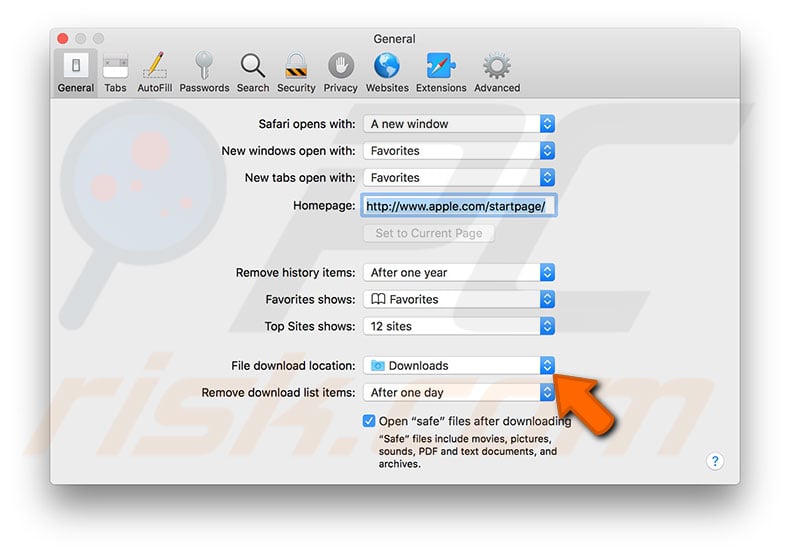This site contains user submitted content, comments and opinions and is for informational purposes only. Apple may provide or recommend responses as a possible solution based on the information provided; every potential issue may involve several factors not detailed in the conversations captured in an electronic forum and Apple can therefore provide no guarantee as to the. Changes you make to a downloaded file appear only on your computer unless you subsequently upload the file to iCloud Drive. In iCloud Drive on iCloud.com, select the files you want to download, then click in the iCloud Drive toolbar. The files are saved in the Downloads folder on your computer (or other folder specified in your web browser’s preference or option settings).
- Change Download Location On Mac
- Change Download Location Mac Airdrop
- Change Download Folder On Macbook Pro
How to change and/or restore default download folder on Safari web browser


Most websites offer a direct download function without additional software. Safari facilitate this process - by default, all files downloaded through this application reach the 'Downloads' folder. Therefore, this folder can quickly become crowded with files, thus making it difficult to find earlier downloads. Fortunately, you can change the destination folder on Safari and others browsers. People use various applications for different purposes, including web browsers. So, reassigning the download folder for browsers and applications can help computer file organisation for work-based activities, leisure, etc. Bookmarks, history, and saved passwords can also save time finding important files within numerous photos, application data, and other information.
Some people choose to save their downloads on the desktop, and this is useful for quick, easy access to files. If you have downloaded files just on a temporary basis, you can easily eliminate them from the Mac. A less popular (but still useful) option is to choose the destination folder each time you download data. This allows you to effectively organise downloaded into different categories. There might also be a number of other reasons you may wish to change the destination of your Safari downloads. In this article, we describe how to change the default downloads folder and also to revert changes to these settings.
Table of Contents:
It is recommended to run a free scan with Malwarebytes - a tool to detect malware and fix computer errors. You will need to purchase the full version to remove infections and eliminate computer errors. Free trial available.

Change downloads destination folder on Safari
Changing the destination folder on the Safari web browser is quite simple. There are a number of different ways to save your download: to the default Downloads folder, a chosen folder, or choose a destination folder each time you download any file. Launch Safari, click Safari in the menu bar at the top of the screen, and then select Preferences. Alternatively, use the keyboard shortcut of Command and Comma (,) to access the Safari's preferences.
Choose the General tab and look for the File Download location option. Click the drop-down menu next to it. You will see the assigned Downloads folder and two additional options. The 'Ask for each download' option will prompt you each time to choose the destination folder for each file - this is useful if you prefer to keep all downloads in separate categories. The 'Other..' option allows you to assign any folder on the Mac storage as your destination for downloads.
When you click this option, a new window will pop-up. Navigate to your desired folder (for example, 'Desktop') from the left hand side bar and then click Select. All downloads will now be saved to the Mac desktop.
You do not need to look for 'Save' or any similar button - simply close Preferences and Safari will automatically save the changes. Bear in mind, however, that these Preference updates will not affect your previous downloads, which will remain in the default Downloads folder. To save time searching for a particular file, click the arrow down button at the top right corner of Safari's window to expand the recent downloads list, and then click the magnifying glass button. In this way, the Mac will automatically open the downloads folder and locate the required file.
Restore default downloads folder on Safari
If you (or other people who use your Mac) have changed the destination folder, you could miss some recently-downloaded files. Fortunately, switching back to the default folder is simple. First, launch the Safari browser, click on Safari in the menu bar at top of the window, and then choose Preferences. Alternatively, use the keyboard shortcut of Command and Comma (,) to access Safari's preferences. In the new window, select the General tab and look for the File Download Location section. Click the drop-down menu next to it and select Downloads from the list.

If you are unable to find this option, click 'Other...' In the new pop-up window go to the user Home folder, select Downloads, and then click Select.
Close Safari Preferences, which will automatically save your changes. From this point, all future downloads will be stored in the default Downloads folder. This will not impact your previous downloads and these files will remain in same location to which they were originally saved. Note that the default Downloads folder is used as the destination folder not only by Safari, but also by most software able to download files to the Mac, including Chrome, Firefox, most SFTP apps, and file transfer features such as AirDrop or Migration Assistant.
Video showing how to change the default downloads folder on Safari
If you take a lot of screenshots on a Mac, you might end up with a cluttered desktop. This is because Macs automatically save your screenshots on the desktop. They are also saved as PNG files instead of the more widely used JPEG format. If you want to know how to change where screenshots are saved on a Mac, and the format they are saved in, just follow the steps below:
Where Do Screenshots Go on a Mac?
When you use keyboard shortcuts like Command + Shift + 3, your screenshots are automatically saved to the desktop. You can also right-click the floating thumbnail, which lets you save the screenshot to Documents or Clipboard.
How to Change Where Screenshots are Saved on a Mac

There are two ways to change the defaultscreenshot save directory on a Mac, depending on your operating system. Theeasier way is through the Screenshot app in macOS Mojave. For mac OS HighSierra or earlier, you have to use Terminal, an app for entering commandprompts to control your Mac. Below are the steps for each operating system.
How to Change Where Screenshots are Saved in macOS Mojave or Later
- Go to the Utilities folder and open the Screenshot app. You can also open the Screenshot app by pressing Command + Shift + 5.
- Click Options. The top tile of the menu will show your Save to options:
- Desktop – This is the default setting which saves the screenshot with the following time format: Screen Shot [date] at [time].
- Documents – This will save the screenshot to your Documents folder with the time and date as the file name.
- Clipboard – This will allow you to paste the screenshot to another app which can edit or view images.
- Mail – This lets you compose a new email in the Mail app with the screenshot attached.
- Messages – This will attach the screenshot to a message which you can send to a contact.
- Preview – This will launch Preview, a photo editing app. Your Mac will temporarily name the image file as Untitled until you change it to a different file name.
- Other Location – This will allow you to navigate outside of the locations previously listed to a folder of your choice. You can save to an existing folder or create a new one.
- Choose a Save To option. Your Mac will remember the last one you have selected and will apply this to subsequent screenshots.
How to Change the Default Screenshot Save Location in macOS High Sierra or Earlier
- Open Terminal. You can find the Terminal app in the Utilities folder.
- Type the following command, followed by a space:
Note: Make sure to put a space after the word location, otherwise the command won’t work.
- Drag the folder you want to save to into the Terminal command box. You will see that the file path will now be inserted as another command line in Terminal.
- Press Enter on your keyboard.
- Then type the following command:
- Press Enter or Return. The next time you take a screenshot, it will be saved to the new folder you have created instead of the desktop.
How to Change a Screenshot to JPG and Other File Formats
Change Download Location On Mac
By default, Macs save screenshots as PNG files, which are usually larger than JPG files. Both can be used for social media, but JPGs are more universally accepted. To save a screenshot as a JPG, use the Terminal to override the default format setting.
- Open Terminal.
- Type the following command, followed by a space: You can also choose to save your screenshots as other formats by default. You can save them as PDF files if you want to edit or open the image in Adobe. You can save them as TIFF files if you want to retain their original image data even after manipulating the image. Or you can save them as GIF files if you want the image to load quickly on the web. Just choose any of the following commands, followed by a space:
Note: Make sure to put a space after the file type, otherwise the command won’t work.
- Hit Enter. The command will be saved to Terminal.
- Test to see if the default option has been changed. Take a screenshot then right-click on the image. Choose Get Info from the contextual menu, then check what is written under “Kind” in the General section.
Once you know how to change the default screenshot settings on your Mac, you’ll be able to customize and improve the way you work with screenshots. Taking a screenshot on a Mac also takes some getting used to, especially for Windows users who are used to hitting the Print Screen key. If you need to improve your screenshot skills, check out our article about how to take a screenshot on a Mac.
Change Download Location Mac Airdrop
Was this article helpful?
Change Download Folder On Macbook Pro
Related Articles
